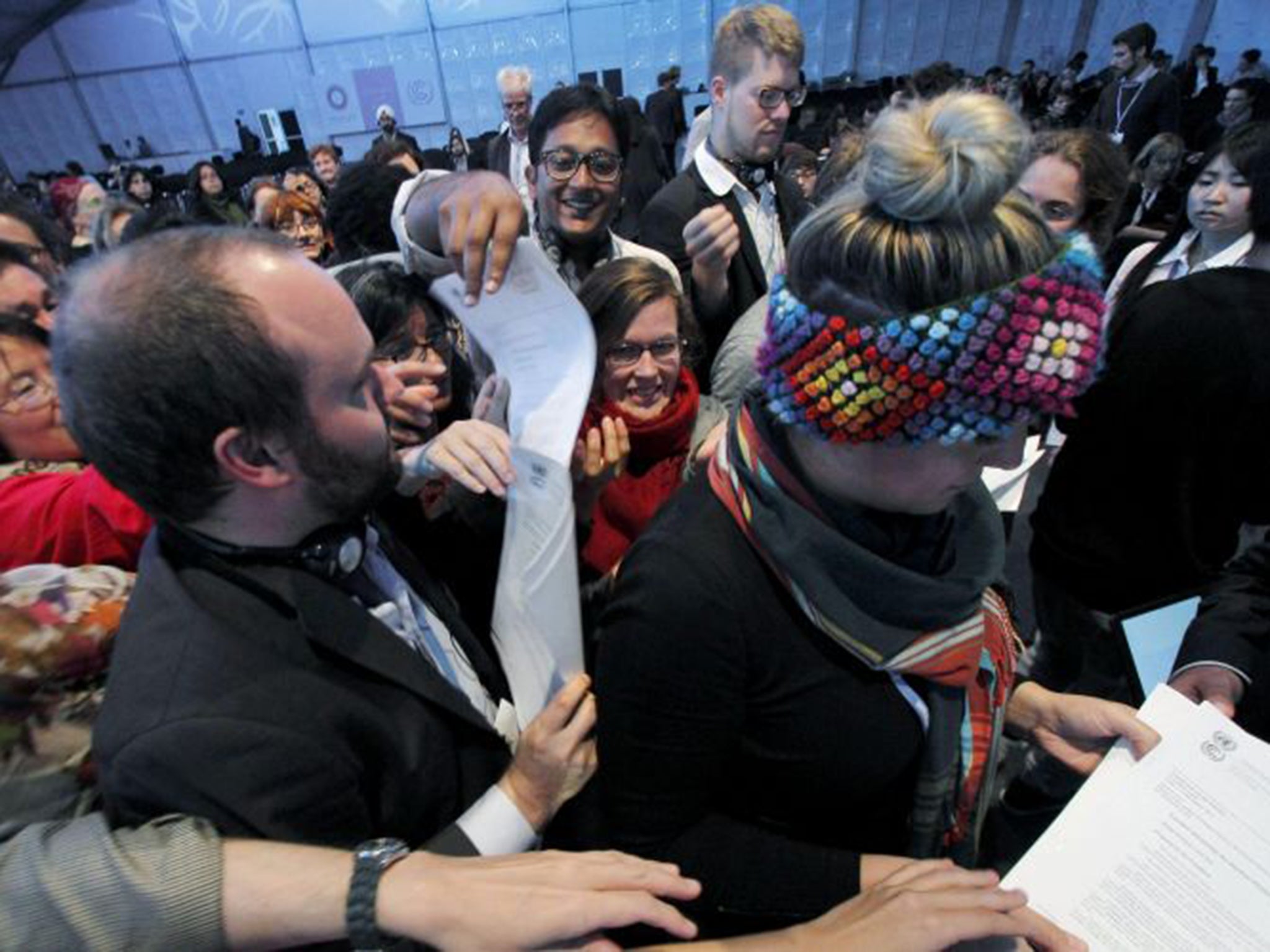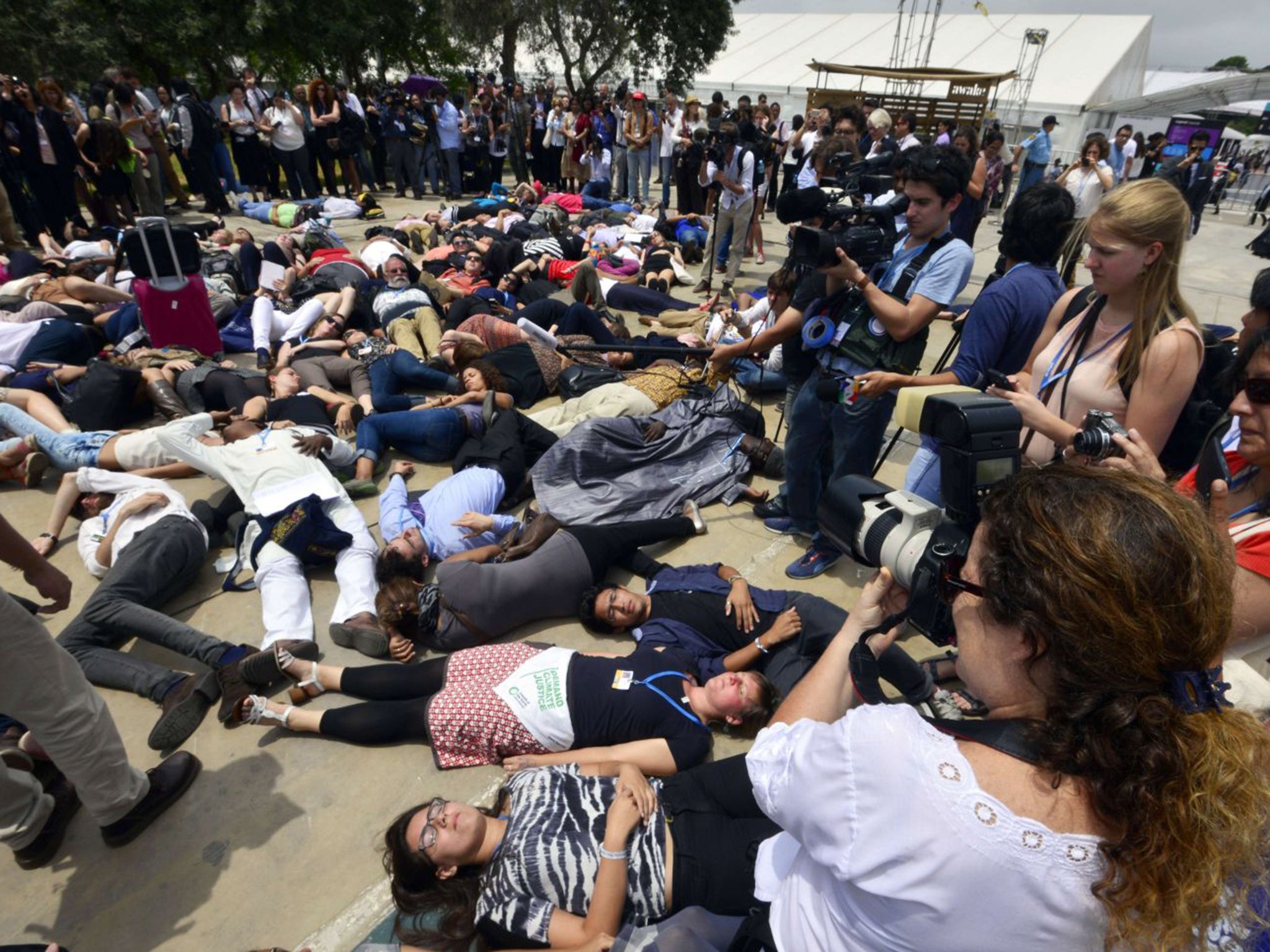UN climate change deal in Peru attacked by environmental activists as 'weak' and 'ineffectual'
Nations sign up to publishing national plans for curbing carbon dioxide emissions

Your support helps us to tell the story
From reproductive rights to climate change to Big Tech, The Independent is on the ground when the story is developing. Whether it's investigating the financials of Elon Musk's pro-Trump PAC or producing our latest documentary, 'The A Word', which shines a light on the American women fighting for reproductive rights, we know how important it is to parse out the facts from the messaging.
At such a critical moment in US history, we need reporters on the ground. Your donation allows us to keep sending journalists to speak to both sides of the story.
The Independent is trusted by Americans across the entire political spectrum. And unlike many other quality news outlets, we choose not to lock Americans out of our reporting and analysis with paywalls. We believe quality journalism should be available to everyone, paid for by those who can afford it.
Your support makes all the difference.The UN climate deal agreed between nearly 200 countries in the early hours of Sunday morning was welcomed by politicians – but environmentalists and climate activists denounced it as both weak and ineffectual.
Differences over the draft text caused the two-week talks in Lima, Peru to overrun by more than a day before a compromise was finally struck.
For the first time, developing and developed nations have all signed up to publishing their national plans for curbing carbon dioxide emissions, although the measures are still hazy and largely voluntary.
Ed Davey, the Energy and Climate Change Secretary, hailed the agreement as critical for next year’s “even more difficult” climate change summit in Paris. This will set out to establish binding international commitments on reducing greenhouse gases to limit global warming to the target threshold of 2C.
“The Lima deal unlocks the door to the big climate change deal that we need in Paris next year. It’s been tough and we’ve stayed up all night to reach this deal, but we have to do it for our children and our grandchildren,” Mr Davey said.
Labour’s Caroline Flint, the shadow Climate Change Secretary, said that it was vital to get both developing and developed nations “on the same page” and agree that they both need to tackle their carbon emissions.
The two-week negotiations in Lima almost collapsed over disagreements between rich and poor nations on who will pay for the poorer nations to adapt to climate change, given that the problem is one largely made by the richer industrialised countries.
“We’ve got what we wanted,” said India’s Minister for Environment and Climate Change, Prakash Javadekar, who said the text of the Lima agreement preserved a notion enshrined in a 1992 UN Climate Convention that the rich have to lead the way in making cuts in greenhouse-gas emissions.
The US, meanwhile, was among wealthier nations that wanted firmer commitments on limiting carbon emissions from fast-growing economies such as India and China. China is now the biggest emitter of greenhouse gases, ahead of the US, the EU and India.
The US Special Envoy for Climate Change, Todd Stern, said that a joint US-China deal last month to curb emissions had helped show new ways to bridge a standoff between rich and poor. “The announcement of a few weeks ago came in handy here,” Mr Stern said.
However, other attendees at the Lima talks were less happy with the final deal, arguing that it was weak and ineffectual, and makes a deal in Paris even more difficult to reach.
“Governments crucially failed to agree on specific plans to cut emissions before 2020 that would have laid the ground for ending the fossil fuel era and accelerated the move towards renewable energy and increased energy efficiency,” said Samantha Smith of the WWF’s global climate initiative.

Lord Stern, chair of the Grantham Research Institute in London, said the Lima deal is an important step towards a new agreement at the climate change summit in Paris next December, but a number of important issues still need to be resolved before then.
“It is vital that countries put before the Paris summit intended nationally determined contributions that are both ambitious and credible,” Lord Stern said.
“That means countries must continue to explore opportunities to increase emissions cuts. And they must build into the Paris agreement arrangements for moving purposefully thereafter to increase the scale of action,” he said.
What is the Lima deal about?
It is an attempt to lay down the ground rules for a crucial climate change summit in Paris next year. This summit is seen as critical for the international attempts to curb the growing concentrations of carbon dioxide and other greenhouse gases in the atmosphere. The ultimate aim is to try to reduce emissions to a level that scientists think will keep the world within the 2C upper target, which they see as a threshold for potentially dangerous climate change.
Does the deal affect anything?
For the first time is brings together both the richer industrialised countries and the poorer developing nations, which have agreed to publish national plans for reigning in their greenhouse gas emissions. The informal deadline for completing this is 31 March 2015, which they hope will give them time to formulate a global agreement for the Paris summit next December.
Didn’t we have a Kyoto climate deal already?
The Kyoto protocol came out of the 1992 UN Framework Convention on Climate Change, the same convention that has led to the Lima deal and Paris summit next year. The goal of the Kyoto protocol was to set limits on overall emissions, by reducing them to at least 5 per cent below 1990 levels by 2012, and was only ever intended as a first step toward implementing the convention. However, it only applied to the richer, industrialised nations. Critics argued this made it weak and useless because it left out the countries such as China and India which were on a course for substantial increases in emissions. Lima and Paris are about what happens to the climate change convention now that the Kyoto protocol ended in 2012.
Why do we need any further agreements on climate change?
The UN Intergovernmental Panel on Climate Change has made it quite clear in a series of influential reports that the global climate is changing, the world is getting hotter and that greenhouse gas emissions are likely to be the main cause. As carbon dioxide emissions continue to increase, governments around the world are being urged to take action to curb the production of greenhouse gases by limiting or even phasing out the burning of fossil fuels, such as coal, oil and gas. The problem is that the richer countries do not want to take action on their own and the poorer nations want fossil fuels to grow their economies quickly.
Join our commenting forum
Join thought-provoking conversations, follow other Independent readers and see their replies
Comments